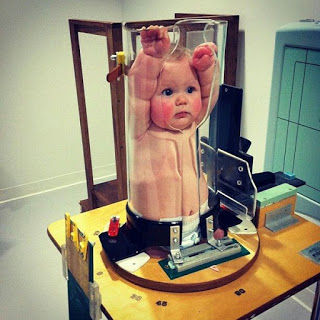This horrible contraption is called a pigg-o-stat.
I have a confession to make. I’ve used it before. On children.
They cried and wailed as I closed the device around their frail forms.
Of course, that was what was supposed to happen.
This particular device was (and may still be) used to ensure that it’s possible to get a good chest x-ray of infants. The plastic holds their arms upright and out of the way. They’re supported and held still. Their legs straddle a miniature bicycle seat.
Oh yes, the crying. That’s on purpose, too.
Babies don’t like being restrained, so they scream like nobody’s business when you put them in this device. And they cry and cry and cry and cry and take a deep breath before crying again.
That’s when you take the x-ray. That deep breath in makes a world of difference in the clarity of the x-ray and ensuring that the radiologist can read it well.
I had a mother once insist she be in the room for her child’s x-rays…and promptly freak out about the pigg-o-stat. Even after I explained its purpose and use, she still insisted that it not be used. My supervisor said I should just go ahead and do as she asked.
She and her husband held the child’s limbs down, spreadeagle, as the infant’s head and back were on the hard edges and surfaces of the x-ray table and film. He struggled and pulled against his parents, and cried erratically.
If I remember correctly, between the child’s struggling, erratic breathing, and parents getting in the way, it took five exposures to get a useable chest x-ray. Five times the radiation exposure… and a barely-readable image.
Let’s not talk about how hard it was to get a lateral picture.
The parents were not subject matter experts in that situation. Their “kindness” did actual, empirical harm to their child (and themselves!) in the form of higher radiation exposure and suboptimal images.
Sometimes knowing why – and knowing how that “why” impacts the outcome – is the difference between something being a good decision or one that hurts those you’re trying to help.
Jumping right in because something seems right or wrong when you don’t have all the information can lead to far worse consequences than you expect.
And it sometimes requires a little bit of distance from the situation to be able to see what the right decision really is.

